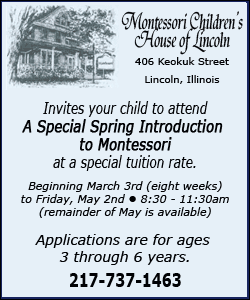 It was always "the fire." His timeline seemed to be marked by before
he joined the army in 1917, the war, and after World War I, which
merged with before "the fire" and then after "the fire." Years
later, I learned the town had actually had two fires within a month,
but to Dad it was "the fire." It was always "the fire." His timeline seemed to be marked by before
he joined the army in 1917, the war, and after World War I, which
merged with before "the fire" and then after "the fire." Years
later, I learned the town had actually had two fires within a month,
but to Dad it was "the fire."
If you never move from your hometown, you live through the town's
events. One knows who married whom, the genders and names of your
friends' new children, when so-and-so died. You hear family history
from multiple relatives, and events just naturally flow. In my case,
our family moved from Lincoln when I was 15, and most of the natural
flow in Lincoln was interrupted for me.

Usually we hear of or witness family history in its making, and
it stays locked inside us. For me it's been a little different. In
1999, Lincoln's Paul E. Gleason's "Lincoln, Illinois: A Pictorial
History" was published, and a year or two later I was given a copy
by my brother, Charles Stringer. The prior summer I had visited
Charles and he had some family pictures, some of our grandfather's
artifacts, and we compared stories we had heard. I borrowed the
family photos and scanned them to my computer.
In Gleason's book I found a page devoted to Mark Holland buzzing
Lincoln with a C-47 (the military version of the then-ubiquitous
Douglas DC-3). I had witnessed Mark's alerting Dad by telegram that
he would buzz Lincoln and again saw the pictures Dad had taken.
Somehow the inside, kid view of the story seemed to need telling. I
wrote the
story, included pictures relating to Mark, and furnished it to
the Lincoln Daily News. LDN published the
story and pictures. I
followed with other stories about the
Lincoln Lakes and the dismantling of the
Postville Courthouse and its resurrection at Greenfield Village.

The first story evoked contacts from Mark Holland's youngest son,
Steve, and my former neighbor on Pekin Street, Betty Koch Baker.
From Mark's son I learned Mark had passed on, but Marcella Campbell
Holland was then still living. Steve shared the Mark story with
Marcella, which she enjoyed shortly before her death. Sadly it
wasn't too long thereafter that Steven followed his mother. From
Betty, I learned what had happened to her and Dan in the intervening
53 years.
Sometime in 2000 or 2001, Leigh Henson, now professor emeritus of
English at Missouri State University, contacted me and others for
our recollections of the town, school years, families or other
events. I found a third-grade class picture our teacher had taken
and given to each child. I shared this and identified as many as I
could recall. Leigh shared it with the others. Serendipitously, one
of the others found her aunt in the picture. This resulted in me
making contact with my former classmates and attending the 50th
reunion of the class. My classmates completed the identifications,
except for one boy, who remained anonymous to all of us.

From the e-mail interchange, recollections intertwined and
stories came forth. These were skillfully woven together with
Leigh's research of prominent citizens and historical events into an
online site entitled
"Mr. Lincoln, Route 66 and Other Highlights about Lincoln,
Illinois." With each story, Leigh included the writer's e-mail
address. LDN generously allowed Leigh's inclusion of the stories I
had written for them. To this I added other stories about my father
and his family, school, the 1932 fires and other events. One of the
prominent citizens Leigh added was C.L. Venard, a photographer Dad
once worked for in Lincoln. To my surprise, a grandson of C.L.
Venard contacted me, and we corresponded for awhile.
[to top of second column]
 |

I was contacted by a family who had a connection to a girl in
that third-grade picture. Regrettably, I couldn't help. Then it
dawned on me that what appeared to be serendipity was being helped
by Google. Other e-contacts came. I answered them or passed them on.
Then I received a contact from Ray Stringer, living near Walsall,
England. Ray was researching his family tree, and he suspected that
my grandfather might be a member of his family line. He identified
where my grandparents had lived in Walsall. However, as we made
further comparisons, it became evident that if we were related, it
would have to be through an earlier generation. There wasn't enough
information to resolve this. For now, Walsall and the "black
country" in the mid-19th century seemed even more remote. Our
correspondence tailed off.

Now a computer crash intervened. I could still get my e-mail on
my wife's computer, but fortunately, I had backed up my pictures and
data a year and a half before my crash. Ray's e-mail address, along
with other addresses, apparently was lost. The depression and
regrets accompanying a computer crash can't compare with loss of a
relative or close friend, but it's still significant. Conversely,
the joy of a new computer is mitigated as one strives to become
accustomed to new software and its idiosyncrasies.
Recently, I was contacted by Hazel Stringer in Yorkshire County,
England. She, too, is researching her family. Hazel had, like Ray,
Googled my grandfather's name. We have compared our family
information, and it is clear, her family emanates from my
grandfather's brother Stephen. We are cousins, and we have much to
share. Hazel has earlier research that may resolve Ray's inquiry.
Recently I learned how I could recover his e-address from my backup
CD. I've since written Ray, and I hope to hear from him.

When I look back on this trans-Atlantic genealogic adventure,
good fortune really arose from sharing family history and stories.
Leigh
Henson's site dealing with Mr. Lincoln and his namesake town is
proving to be a unique vehicle. Tracing family history is done using
typical genealogical tools and research methods, but family stories
on the Internet are like casting bread upon the waters; they return
again in greater portions.
Writing a family story does not mean that a family history has to
be written, but a family story that relates to our town or village
in our county helps to open the door to Internet genealogy research
and making family connections. It also helps preserve family
history. My advice: Write a story about something you have seen or
heard about from family members who saw it. If there are pictures or
newspaper accounts that relate to the subject, use them as a
resource. Keep it factual, and if appropriate include humor. Writing
is a skill best acquired by writing that is supplemented with
objective and friendly criticism. Join a historical-genealogy
society or a writers club.
Stories are not automatically published, but if a piece is
interesting or adds something to the local knowledge, publishers
will be interested. Logan County is fortunate to have four
publishers, any of which may become interested in a local family
story: Leigh Henson's site, the Lincoln Daily News, the Lincoln
Courier and the Logan County Genealogical and Historical Society's
newsletter Roots and Branches.
[By STAN STRINGER]
Related subject:
|